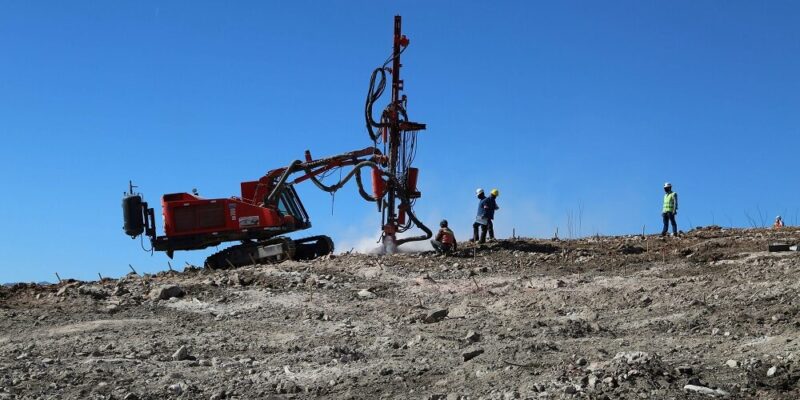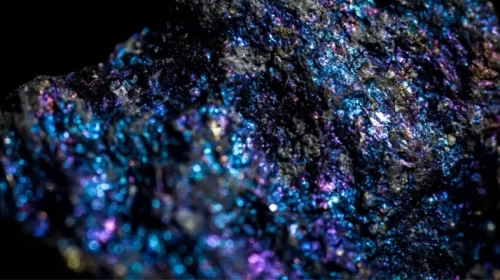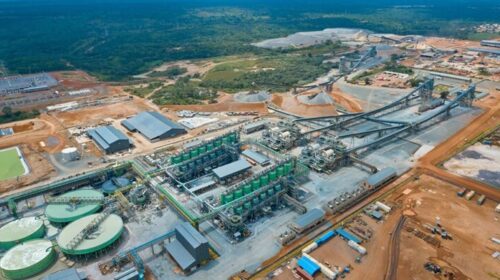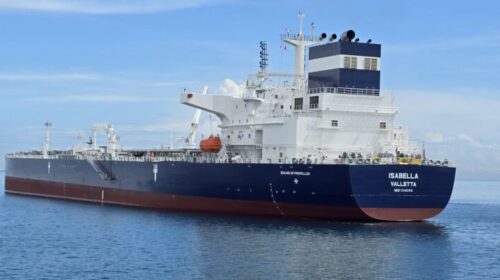BEMETALS IDENTIFIES COMPELLING COPPER EXPLORATION TARGETS AT PANGENI PROJECT IN ZAMBIA
BeMetals Corp. is pleased to announce the results from a phase of some 4,350 metres of shallow aircore drilling recently completed at the Pangeni Copper Project (“Project” or the “Property”) in Zambia. This aircore program was designed to explore for extensions of copper mineralization discovered by the Company under thin Kalahari sand cover at several prospects, including the D Prospect, and to test several newly generated copper targets. The Pangeni Project is located in an area representing westerly extensions to the prolific Zambian Copperbelt.
HIGHLIGHTS OF THE 2021 PANGENI PROJECT AIRCORE PROGRAM
- D-Prospect returns highest tenor aircore copper target in hole D7-04 on the Property to date of 3,183 parts per million (ppm) over 2 metres with 1 metre at 4,363ppm
- Potential D-Prospect extension zone identified in aircore hole D3-15 of 1,217ppm copper over 3 metres with 1 metre at 1,344ppm some 1.4 kilometres southeast of previously drilled mineralization
- Newly identified F – Target
- Newly identified Q – Target some 3km southeast of the SW-Prospect
John Wilton, President and CEO of BeMetals stated, “We are encouraged with the results from the 2021 phase of shallow aircore drilling below the thin sand cover that has delivered a number of robust bedrock copper targets. These targets are potential extensions and/or potential vectors to higher-grade zones of copper mineralization we discovered in previous phases of drilling. In addition, a number of new standalone targets well situated geologically within the Property have been identified. To follow-up on these recent aircore results, we have commenced a program of approximately 1,400 metres of core drilling to test these compelling copper targets. We look forward to the results of the core drilling program that has the potential to both expand the footprint of the D-Prospect mineralization and test the exciting newly identified copper targets.
This exploration program continues to be jointly funded by BeMetals and Japan, Oil, Gas and Metals National Corporation (“JOGMEC”) that has allowed for acceleration of our exploration program. The Pangeni Project, together with our recently acquired Kazan Gold Project in Japan and ongoing exploration at the high-grade zinc-silver-gold-copper, South Mountain Project in Idaho, U.S.A., provides an excellent and building portfolio of projects with exciting growth potential for the Company.
2021 PANGENI PROJECT EXPLORATION AND AIRCORE PROGRAM
Early in June the Company commissioned New Resolution Geophysics (NRG™) to fly an Xcite™ helicopter-borne electromagnetic survey over the Property and the interpretation of this data was used to define targets through improved stratigraphic and structural mapping for subsequent aircore testing. The Company has successfully completed a program of 4,353 metres of shallow aircore drilling and returned a number of significant bedrock copper geochemical targets beneath the Kalahari sand cover. These new bedrock copper targets represent both potential extensions to prospects where the Company discovered copper mineralization in previous phases of exploration and newly identified standalone targets in interpreted favourable geological settings for the development of sediment hosted copper deposits.
Figure 1 illustrates the location of the D7-C1, D3-C2, F4-C1, and Q3-C1 targets within the Project area. It also indicates the range of maximum copper values for each aircore hole from the recently completed 2021 program in blue circles with results from the previous phases of aircore drilling in the red circles.
Figure 1: 2021 Aircore Drilling Results (Blue Circles) and Previous Aircore Results (Red Circles)
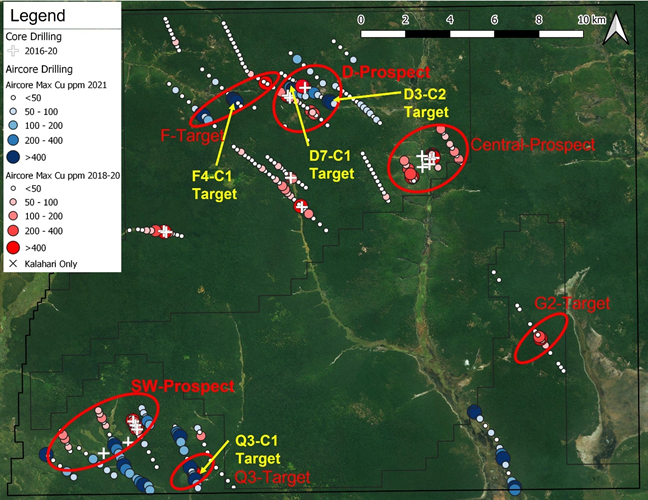
D-PROSPECTS
Figure 2 shows details of the 2021 aircore results plotted on a simplified cover regolith map of the D-Prospect area. The circles and labels indicate the range of maximum bedrock copper results for each shallow aircore hole in relation to the Company’s previous core drilled copper intersections at this prospect (aircore holes: D2-C1, D2-C2 and D3-C1). The highly anomalous D7-04 aircore target is indicated as 3,183ppm copper over 2 metres with the supporting adjacent D7-4A aircore hole returning 1,802ppm copper over 2 metres. The wide spacing of the D2, D7 and D3 aircore lines should be noted at some 400 metres along the interpreted strike of the units indicating the significant footprint of the mineralization.
Also indicated is the D-Prospect’s southeastern extension target some 1.4km from previous intersected mineralization as defined by aircore target D3-15 of 1,217ppm copper over 3 metres and supported by the adjacent D3-15B hole with 434ppm copper over 2 metres. Over much of these two D-Prospect targets the cover of the Kalahari sand is less than approximately 25 metres in thickness (See Tables 1 and 2 for details of these aircore holes).
Figure 2: D-Prospect Regolith Cover Map, 2021 Aircore Drilling Results as ppm Copper (Blue Circles with hole number, ppm Cu), Previous Aircore Results (Red Circles with ppm Cu) and Previous Drilled Core Hole Copper Intersections.
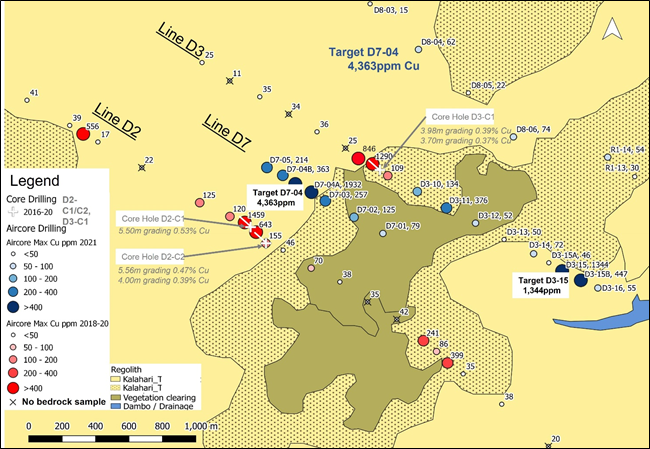
NEWLY IDENTIFIED AND DEFINED COPPER TARGETS
The 2021 aircore program has also identified and defined several new standalone copper targets for core drill testing. The F-Target represents a geological well-positioned bedrock copper geochemical anomaly with potentially several kilometres in strike. This anomaly is best indicated at the F4-C1 target where aircore holes F4-2A, F4-02 and F4-2B returned bedrock samples of 717 over 3 metres with 1,113 over 1 metre, 782 over 4 metres with 1,052 over 1 metre and 893 ppm copper over 1 metre respectively as adjacent holes over some 200 metres of lateral extent. The Q3-C1 Target, situated some 4km to the southeast of the SW-Prospect, has been defined by aircore holes Q3-09 and Q3-12 with 884 over 1 metre and 502ppm over 1 metre copper respectively. The centre of this target is mapped by aircore holes Q3-02 and Q3-03 with 1,260 over 3 metres with 2,146 over 1 metre and 982 over 5 metres with 1,545ppm over 1 metre copper respectively that were completed in the 2020 exploration program.
Table 1: 2021 Aircore Program Selected Hole Results
| Aircore Hole ID | From (m) | To (m) | Sample Interval (m) | Copper (ppm) | Kalahari Sand Thickness |
| D7-04 | 27 | 28 | 1 | 4,363 | – |
| D7-04 | 28 | 29 | 1 | 2,004 | 26 |
| D7-4A | 25 | 26 | 1 | 1,672 | – |
| D7-4A | 26 | 27 | 1 | 1,932 | 24 |
| D3-15 | 36 | 37 | 1 | 1,266 | – |
| D3-15 | 37 | 38 | 1 | 1,344 | – |
| D3-15 | 38 | 39 | 1 | 1,041 | 34 |
| D3-15B | 27 | 28 | 1 | 447 | – |
| D3-15B | 28 | 29 | 1 | 422 | 25 |
| F4-2A | 27 | 28 | 1 | 508 | – |
| F4-2A | 28 | 29 | 1 | 531 | – |
| F4-2A | 29 | 30 | 1 | 1,113 | 26 |
| F4-02 | 20 | 21 | 1 | 586 | – |
| F4-02 | 21 | 22 | 1 | 580 | – |
| F4-02 | 22 | 23 | 1 | 913 | – |
| F4-02 | 23 | 24 | 1 | 1,051 | 20 |
| F4-2B | 26 | 27 | 1 | 893 | 23 |
| Q3-09 | 70 | 71 | 1 | 884 | 69 |
| Q3-12 | 62 | 63 | 1 | 502 | 60 |
| Q3-02* | 59 | 60 | 1 | 2,146 | – |
| Q3-02 | 60 | 61 | 1 | 558 | – |
| Q3-02 | 61 | 62 | 1 | 1,077 | 56 |
| Q3-03* | 56 | 57 | 1 | 753 | – |
| Q3-03 | 57 | 58 | 1 | 824 | – |
| Q3-03 | 58 | 59 | 1 | 977 | – |
| Q3-03 | 59 | 60 | 1 | 1,545 | – |
| Q3-03 | 60 | 61 | 1 | 814 | 56 |
| *Results from 2020 Aircore Program Previously Reported |
Note: Sample widths are drilled lengths as true widths are unknown at this time. The aircore drilling is intended to sample the bedrock and saprolite material at the base of the Kalahari sand cover only and holes are stopped generally between 3-5m of this contact.
QUALITY ASSURANCE AND QUALITY CONTROL
On September 15, 2021, an independent laboratory, Intertek Genalysis of Australia, provided results from a set of samples from the 2021 aircore program. These results were determined using multi-acid, near total digest, and analysed by Inductively Coupled Plasma (“ICP”) Optical (Atomic) Emission Spectrometry (“OES”). The sampling was conducted with a robust sampling protocol based upon sequential 1 metre samples that included the appropriate insertion of standard reference material, duplicates, and blanks into the sample stream in the field.
Field operations and management have been provided by Remote Exploration Services (“RES”) an independent geological consulting and contracting company. The aircore drilling was conducted by Blurock Mining Services, of Kitwe, Zambia. Details of the sampling protocol were provided in BeMetals news release “BeMetals Returns Positive Results From Phase 1 Aircore Drilling Program At Pangeni Copper Project,” dated November 15, 2018, available on www.bemetalscorp.com and SEDAR.
Table 2: 2021 Aircore Program Selected Hole Results, Hole ID, Azimuth, Dip, End of Hole Depth, Collar co-ordinates
| Aircore Hole ID | Azimuth Degree | Dip Degree | End of hole Depth (m) | UTM_X | UTM_Y | Elevation |
| D7-04 | Vertical | -90 | 29 | 177549 | 8601553 | 1314 |
| D7-4A | Vertical | -90 | 27 | 177646 | 8601502 | 1304 |
| D3-15 | Vertical | -90 | 39 | 179148 | 8601021 | 1249 |
| D3-15B | Vertical | -90 | 30 | 179260 | 8600964 | 1242 |
| F4-2A | Vertical | -90 | 30 | 174964 | 8601003 | 1314 |
| F4-02 | Vertical | -90 | 24 | 174883 | 8601077 | 1290 |
| F4-2B | Vertical | -90 | 27 | 174823 | 8601142 | 1309 |
| Q3-09 | Vertical | -90 | 71 | 172890 | 8584552 | 1164 |
| Q3-12 | Vertical | -90 | 64 | 173108 | 8583998 | 1155 |
| Q3-02 | Vertical | -90 | 64 | 173036 | 8584357 | 1159 |
| Q3-03 | Vertical | -90 | 61 |
119 total views , 1 views today


